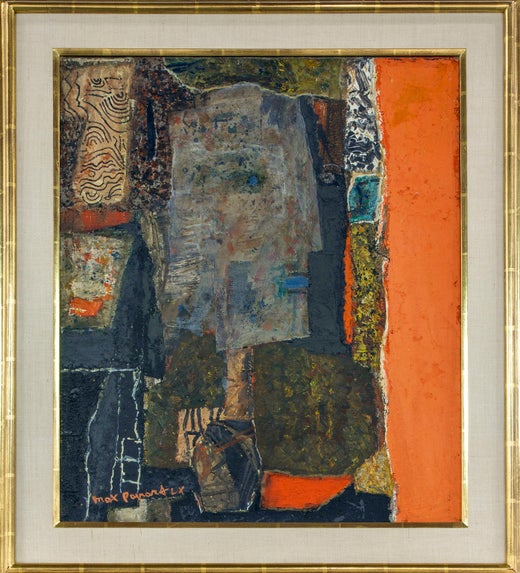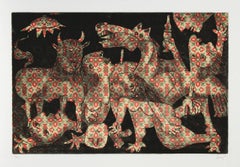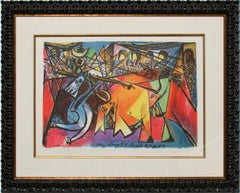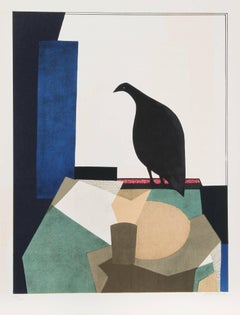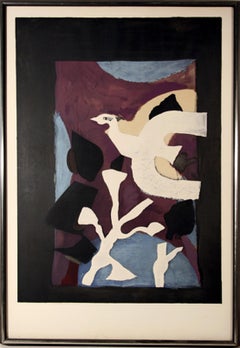Want more images or videos?
Request additional images or videos from the seller
1 of 6
Max PapartAcrobat, Aquatint Etching by Max Papartcirca 1982
circa 1982
$1,700List Price
About the Item
- Creator:Max Papart (1911 - 1994, French)
- Creation Year:circa 1982
- Dimensions:Height: 30 in (76.2 cm)Width: 42 in (106.68 cm)
- Medium:
- Movement & Style:
- Period:
- Framing:Framing Options Available
- Condition:
- Gallery Location:Long Island City, NY
- Reference Number:1stDibs: LU4666625792
Max Papart
Max Papart (1911-1994), was born in Marseille, France and later moved to Paris where he learned the techniques of classic engraving. One of the most intriguing intellectual concepts which Papart achieved is a "window" through which the viewer senses the past or future, or even another time or place. It has been said that Papart does not "paint," he "composes." His compositions come together in a symphony of line, shape and colour. Papart always believed that each painting has its own meaning and needed no interpretation from him. His paintings, in his own words, 'force the viewer to think, and it is for the viewer to respond to the art based on his own personal experiences (Rogallery). Papart's original art pieces such as this one are auctioned at the world's most prominent houses and are eminently collectible. You will find his works often sold side-by-side with Picassos, Chagals and Braques.
About the Seller
4.9
Platinum Seller
Premium sellers with a 4.7+ rating and 24-hour response times
Established in 1979
1stDibs seller since 2014
3,197 sales on 1stDibs
Typical response time: 1 hour
Authenticity Guarantee
In the unlikely event there’s an issue with an item’s authenticity, contact us within 1 year for a full refund. DetailsMoney-Back Guarantee
If your item is not as described, is damaged in transit, or does not arrive, contact us within 7 days for a full refund. Details24-Hour Cancellation
You have a 24-hour grace period in which to reconsider your purchase, with no questions asked.Vetted Professional Sellers
Our world-class sellers must adhere to strict standards for service and quality, maintaining the integrity of our listings.Price-Match Guarantee
If you find that a seller listed the same item for a lower price elsewhere, we’ll match it.Trusted Global Delivery
Our best-in-class carrier network provides specialized shipping options worldwide, including custom delivery.You May Also Like
Le Singe - Etching by Pablo Picasso - 1940s
By Pablo Picasso
Located in Roma, IT
Etching, aquatint and drypoint. Not Signed and not Numbered as issued.
Edition of 226 pieces.
Belongs to the Suite "Histoire Naturelle de Buffon" (plate p. 86).
Printed by Lacourièr...
Category
1940s Cubist Figurative Prints
Materials
Paper, Etching, Drypoint, Aquatint
$2,872
H 27.56 in W 19.69 in D 0.04 in
Migration - Etching by Georges Braque - 1962
By Georges Braque
Located in Roma, IT
" Migration " is an etching realized by Georges Braque in 1962. The print is hand signed and numbered. This is an edition of 90 prints.
Bibliography: D. Vallier, Braque : l'oeuvre gravé: catalogue raisonné , Flammarion, Paris 1982, p.241, n.72.
Georges Braque (1882-1963) was a French Fauve painter who began to rethink his own painting style after admiring Picasso’s Les Demoiselles...
Category
1960s Cubist Animal Prints
Materials
Etching
$4,068
H 18.9 in W 14.77 in D 0.04 in
Head of a Bull (Plate XXXII), from Carmen
By Pablo Picasso
Located in Washington, DC
Artist: Pablo Picasso
Title: Head of a Bull (Plate XXXII)
Portfolio: Carmen
Medium: Etching on Montval wove paper
Year: 1949
Edition: 289
Sheet Size: 13" x 10 3/16"
Signed: No (signe...
Category
1940s Cubist Animal Prints
Materials
Etching
LE PEINTRE A LA PALETTE (BLOCH 1153)
By Pablo Picasso
Located in Aventura, FL
Linocut on Arches wove paper. Hand signed and numbered by the artist in pencil. Image size 25 x 20.75 inches. Sheet size 29.6 x 24.5 inches. Frame size approx 34.5 x 29.5 inches. Pri...
Category
1960s Cubist Animal Prints
Materials
Paper, Linocut
After Georges Braque - Antiborée - Lithograph
Located in Collonge Bellerive, Geneve, CH
Lithograph after Georges Braque.
Signed in the plate
Edition of 150
Dimensions: 76 x 117 cm
Bibliography:
« Les Métamorphoses de Braque» of Heger de Loewenfeld and Raphaël de Cuttoli , Editions FAC, Paris, 1989.
In 1961 Georges Braque decided with his laidary friend Heger de Loewenfeld to pick up certain of his works to in order to create artworks, this beautiful litograph is one of them.
Héméra in the Mythology:
In Greek mythology Hemera was the personification of day and one of the Greek primordial deities. She is the goddess of the daytime and, according to Hesiod, the daughter of Erebus and Nyx (the goddess of night). Hemera is remarked upon in Cicero's De Natura Deorum, where it is logically determined that Dies (Hemera) must be a god, if Uranus is a god. The poet Bacchylides states that Nyx and Chronos are the parents, but Hyginus in his preface to the Fabulae mentions Chaos as the mother/father and Nyx as her sister.
She was the female counterpart of her brother and consort, Aether (Light), but neither of them figured actively in myth or cult. Hyginus lists their children as Uranus, Gaia, and Thalassa (the primordial sea goddess), while Hesiod only lists Thalassa as their child.
The father of Cubism
Three Cubist that distinguishes art historian periods were initiated and developed by Georges Braque: The Cubist Cézanne (1907-1909), Executive (1909-1912) and synthetic (1912-1922).
Post-Impressionist and fawn, Braque no longer adheres to the contingency of a decorative way or the other. Cézanne’s paintings exhibited at the Grand Palais during the retrospective of 1907 are a revelation: Cézanne sought and invented a pictorial language. In his footsteps, Braque went to the South with the reasons of the Master. He returned with Estaque landscapes and surprising Ciotat it keeps Cezanne geometric model and retains the “passages” continuity from one surface to another to create the sensation of “turning around” of the object represented. But he wants to go after the consequences of the vision of Cezanne. In his paintings Houses in L’Estaque (1908) it simplifies the volumes of houses, neglects detail by removing doors and windows: the plastic rhythm that builds the table. Large Nude , a masterpiece of the period, can be considered the first work of Cézanne cubism .
Systematizing and deepening Braque discoveries open the door analytical cubism. In 1909, his painting became more cerebral than sensual. The pattern is recreated in the two-dimensionality of the canvas, leaving aside any illusionistic perspective. In Still Life with Violin, objects are analyzed facets according to their characteristic elements, each facet referring to a particular view of the object. There are so many facets of points selected view: Table reflects the knowledge of the object and the ubiquity of the eye. Moreover, Braque is looking for the essence of the objects in the world rather than their contingency, which explains the absence of light source and use of muted colors (gray, ocher), contingent aspects of the object . But formal logic has stepped facets, erased any anecdote to the object and ultimately led to his painting a hermetic more marked on the edge of abstraction (see the series of Castle Roche-Guyon ).
Braque, anxious to keep the concrete and refusing at all costs that the logic of Cubism takes the paintings to abstract, reintroduced signs of reality in his paintings in 1912 marks the beginning of Synthetic Cubism. Historians speak of “signs of real” rather than reality because what interests Braque, this is not to put reality into a table, but to create a painting which, by its language, refers to the real. To do this, he invented two major techniques XX th century inclusions and contributions. The inclusions consist of painting objects that have no real depth, materials (wallpaper in Nature morte aux playing cards faux wood is a pictorial inclusion) or letters (calligraphic inclusion in Portuguese ), made first brush and a few months later stencil. Contributions are defined in contrast with the collage on canvas of foreign materials: glued or sand paper, sawdust, etc.. Regarding the collages, Braque used for the first time in September 1912 a piece of adhesive paper imitating faux wood Compote...
Category
1950s Cubist Animal Prints
Materials
Lithograph
Lettera Amorosa
By George Braque
Located in San Francisco, CA
This artwork titled "Lettera Amorosa" 1963, is an original color lithograph on Japan nacre paper by renown French artist Georges Braque, 1882-1963. It is hand signed and numbered 42/...
Category
Mid-20th Century Cubist Abstract Prints
Materials
Lithograph
Elegant flight - Lithograph - Printed signature
By (after) Georges Braque
Located in Paris, IDF
George BRAQUE
Elegant flight
Lithograph on vellum after a painting
Printed signature in the plate
399 copies unnumbered
On Arches vellum 18 x 23" (45 x 58 cm)
Excellent condition
Category
Late 20th Century Cubist Animal Prints
Materials
Lithograph
MAMELOUK ENLEVANT UNE FEMME, ATTAQUE PAR UN MOUSQUETAIRE (BLOCH 1586)
By Pablo Picasso
Located in Aventura, FL
Aquatint on wove paper. Hand signed and numbered by Pablo Picasso. Plate 106, from the serie "347 gravures" (B. 1586; BA. 1602 II B b 1). Published by Galerie Louise Leiris, Paris. ...
Category
1960s Cubist Animal Prints
Materials
Paper, Engraving
$15,600 Sale Price
20% Off
H 14.29 in W 18.62 in
Secret thoughts - lithograph - 399 copies
By (after) Georges Braque
Located in Paris, IDF
MEDIUM : Lithograph
PRINTER : Atelier Art-Litho
EDITOR : Armand ISRAEL, Paris
SIGNATURE : Printed
LIMITED : 399 copies unumbered
PAPER : Arches vellum
SIZE : 18 x 23"
CONDITION : Ex...
Category
Late 20th Century Cubist Animal Prints
Materials
Lithograph
Leda and the Swann - lithograph - 399 copies
By (after) Georges Braque
Located in Paris, IDF
Georges BRAQUE
Leda and the Swann
Stone lithograph (Art-Litho workshop, Paris)
Printed signature in the pate
Limited to 399 copies unumbered
On Arches vellum 18 x 23" (45 x 58 cm)
E...
Category
Late 20th Century Cubist Animal Prints
Materials
Lithograph
More From This Seller
View AllBaj Chez Picasso 2, Cubist Aquatint Etching by Enrico Baj
By Enrico Baj
Located in Long Island City, NY
Artist: Enrico Baj, Italian (1924 - 2003)
Title: Baj Chez Picasso 2
Year: 1969
Medium: Aquatint Etching, Signed and numbered in pencil
Edition: 86/100
Image Size: 15 x 22 inches...
Category
1960s Cubist Animal Prints
Materials
Etching, Aquatint
Course de Taureaux, Cubist Lithograph after Pablo Picasso
By Pablo Picasso
Located in Long Island City, NY
Comprised of shapes with lines and sharp angles, this composition depicting the running of the bulls is hectic and energized. Rendered in gradiated rainbow colors, the animals in thi...
Category
1980s Cubist Animal Prints
Materials
Lithograph
"Amour from the Helene Portfolio" Lithograph by Andre Minaux
By Andre Minaux
Located in Long Island City, NY
Artist: Andre Minaux, French (1923 - 1986)
Title: Amour from the Helene Portfolio
Year: 1974
Medium: Lithograph, signed and numbered in pencil
Edition: 150, XXX
Size: 25.75 in. x 19....
Category
1970s Cubist Animal Prints
Materials
Lithograph
Derniers Messages, Cubist Lithograph by Georges Braque
By Georges Braque
Located in Long Island City, NY
Georges Braque, French (1882 - 1963) - Derniers Messages, Year: circa 1965, Medium: Lithograph, Image Size: 23.5 x 17 inches, Frame Size: 28 x 19.5 inches
Category
1960s Cubist Animal Prints
Materials
Lithograph
Three Birds, Cubist Lithograph Poster after Georges Braque
By Georges Braque
Located in Long Island City, NY
Georges Braque, After, French (1882 - 1963) - Three Birds, Year: circa 1960, Medium: Lithograph Poster, Image Size: 34.5 x 23 inches, Size: 37 x 25.5 in. (93.98 x 64.77 cm), Prin...
Category
1960s Cubist Animal Prints
Materials
Lithograph, Offset
Bactrian Camel, Surrealist Etching and Aquatint by Martin Barooshian
By Martin Barooshian
Located in Long Island City, NY
Martin Barooshian, American (1929 - 2022) - Bactrian Camel, Year: circa 1979, Medium: Etching and Aquatint, signed, titled and numbered in pencil, Edition: 50/60, Image Size: 6...
Category
1970s Surrealist Animal Prints
Materials
Etching, Aquatint
Still Thinking About These?
All Recently ViewedRead More
Romare Bearden’s Humanity Infuses His Bright, Bold Art
Through collage, painting and printmaking, the artist foregrounded Black life in America in revolutionary new ways.
Chryssa’s 1962 Neon Sculpture Was Way ahead of the Art-World Curve
By working with lettering, neon and Pop imagery, Chryssa pioneered several postmodern themes at a time when most male artists detested commercial mediums.
